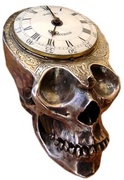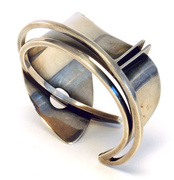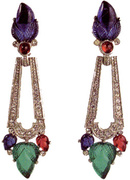
Two years ago, when Agram.m posted a Croix à la Jeannette on Show & Tell, we knew a discerning collector had just joined our growing community. Based in Europe, Agram.m quickly became our site’s most vocal champion of Georgian, Victorian, and Edwardian jewelry. She was especially fond of micro mosaics from the 19th century. With each of her hundreds of posts and comments, Agram.m has increased the knowledge base of those who appreciate the history, workmanship, and beauty of fine jewelry. Here is her report from a recent visit to the Schmuckmuseum in Germany.
Recently, I visited the Schmuckmuseum in Pforzheim, Germany (see slideshow below), which is the world’s only museum devoted entirely to jewelry (the translation of Schmuckmuseum from German to English is ‘jewelry museum’). The jewelry tradition in Pforzheim goes back to 1767, when Karl Friedrich, the Grand Duke of Baden, gave his blessing to the jewelry and watchmaking trades. The core of the Schmuckmuseum’s collection was amassed in the late 19th century by the Groβherzoglich-Badische Kuntstgewerbeschule (School for the Applied Arts), which acquired original examples of old pieces for study by its students, as well as the Revival Style designers employed by Pforzheim’s numerous jewelry factories.
Pieces in the Pforzheim collection date from the 3rd millennium BC to the 21st century
Today, the Schmuckmuseum’s collection contains thousands of historical and contemporary items from Greek, Etruscan, and Roman antiquity; the Renaissance and Baroque eras; and the Art Nouveau period, which is known in Germany as Jugendstil. The earliest pieces in the Pforzheim collection date from the latter half of the third millennium BC; the most recent ones were created in 2004. In addition, the museum holds almost 1,200 rings from ancient Persia, Asia Minor, Egypt, Greece, Rome, and all periods of European history up to the present. Also at the Schmuckmuseum is a precious collection consisting of bracelets, pocket watches, and watches worn as decorative accessories; for example, as pendants or set in rings. There’s also a fine collection of ethnographic jewelry brought together by Pforzheim collectors Eva and Peter Herion over a period of more than 30 years; the Herion collection is on view at the museum as a semi-permanent exhibition.
Thanks to the pieces acquired in the 19th century, as well as subsequent private donations and ongoing support from the International Society of the Friends of the Pforzheim Jewelry Museum, the holdings of the Schmuckmuseum are easily on the same level as jewelry collections found at the Victoria & Albert Museum in London and the Musée des Arts Décoratifs in Paris.
Slideshow: Selected Jewels of Pforzheim
We’d like to thank Agram.m for bringing this amazing resource to our attention. For her part, Agram.m would like to thank Isabel Schmidt-Mappes from the Schmuckmuseum Pforzheim, AR8Jason, and MrsAR8Jason.













 Jewelry as Sculpture: The Birth of Modernist Studio Jewelry
Jewelry as Sculpture: The Birth of Modernist Studio Jewelry
 Hayden Peters Talks About Skulls, Hairwork, and the Fashion of Mourning
Hayden Peters Talks About Skulls, Hairwork, and the Fashion of Mourning Jewelry as Sculpture: The Birth of Modernist Studio Jewelry
Jewelry as Sculpture: The Birth of Modernist Studio Jewelry Christie Romero on Differences Between Fine and Costume Jewelry Over the Decades
Christie Romero on Differences Between Fine and Costume Jewelry Over the Decades Fine JewelryFrom delicate, Victorian filigree necklaces to loud, diamond-studded choker…
Fine JewelryFrom delicate, Victorian filigree necklaces to loud, diamond-studded choker… Mari Tepper: Laying it on the Line
Mari Tepper: Laying it on the Line Nice Ice: Valerie Hammond on the Genteel Charm of Vintage Canadian Costume Jewelry
Nice Ice: Valerie Hammond on the Genteel Charm of Vintage Canadian Costume Jewelry How Jim Heimann Got Crazy for California Architecture
How Jim Heimann Got Crazy for California Architecture Modernist Man: Jock Peters May Be the Most Influential Architect You've Never Heard Of
Modernist Man: Jock Peters May Be the Most Influential Architect You've Never Heard Of Meet Cute: Were Kokeshi Dolls the Models for Hello Kitty, Pokemon, and Be@rbrick?
Meet Cute: Were Kokeshi Dolls the Models for Hello Kitty, Pokemon, and Be@rbrick? When the King of Comedy Posters Set His Surreal Sights on the World of Rock 'n' Roll
When the King of Comedy Posters Set His Surreal Sights on the World of Rock 'n' Roll How One Artist Makes New Art From Old Coloring Books and Found Photos
How One Artist Makes New Art From Old Coloring Books and Found Photos Say Cheese! How Bad Photography Has Changed Our Definition of Good Pictures
Say Cheese! How Bad Photography Has Changed Our Definition of Good Pictures Middle Earthenware: One Family's Quest to Reclaim Its Place in British Pottery History
Middle Earthenware: One Family's Quest to Reclaim Its Place in British Pottery History Fancy Fowl: How an Evil Sea Captain and a Beloved Queen Made the World Crave KFC
Fancy Fowl: How an Evil Sea Captain and a Beloved Queen Made the World Crave KFC
FYI … Sallie Mackey is also known as MRSAR8Jason, also of CW’s Show and Tell.
Beautiful pictures to go with your article. Very nice Agram.m. Thank you.
The jewelry museum is like a miracle! Unbelieveable!
The museum is a great place to visit, and these photos are a treat! Thanks, Agram.m!
I can’t wait to visit this museum! Thank you for sharing your knowledge on CW.
Many thanks Agram!
I have always been intrigued by antiquities of almost any type…but this jewelry takes my breath away! Thank you so very much for making this experience possible!
Could you please tell me something about the gold watch Hallmarks that came from your town. My friend (Joe Swann) thinks he might have a Christphor Becthler Pocket
watch. Thanks, Margaret Ledford
The Pforzheim jewelry museum is beyond incredible and a must-see for anyone interested in the subject. They especially excel in Renaissance and other pre-Georgian jewelry with possibly the best collection of those eras, including the V&A. Also some marvellous Art Nouveau items from France. However, I was very disappointed and surprised that their collection of Pforzheim jewelry from circa 1900 era is very small and not terribly illustrative. That’s exactly what I went there to see – it is Pforzheim after all.
Got nothing to write about me at all.
Lovely to be a member of this site.
I just wish I am useful at all http://www.pforzheim.de
I seek the history of Pforzheim jewelry, chiefly connections among early 1870s spiral wound tube jewelry, German engineering, English production of interlocked hose and an American company backed by Pforzheim funding.
After 1901, Julius Khan in the United States formed the New York Flexible Metallic Hose company with financial backing from an individual or company in Pforzheim, Germany. A royalty agreement made profitability difficult until 1912. Sales doubled in that year. I find no other mention of Pforzheim in the records I see.